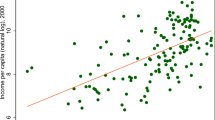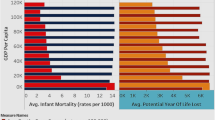Abstract
We estimate the long-run cointegrating relationship between schooling and income inequality using annual data from 48 contiguous U.S. states between 1946 and 2000. Our study contributes to the literature in several ways in terms of data and empirical methodology. First, we take into account integration and cointegration properties of the data and estimate the cointegrating relationship between schooling and income inequality using Fully Modified OLS (FMOLS) following Pedroni (2000, 2001). Second we investigate the direction of the causality. Using several different measures of income inequality, we find that an increase in the average level of schooling decreases income inequality in the long-run and (Granger) causality runs from schooling to income inequality, not the other way around.
Similar content being viewed by others
Notes
For a meta analysis of schooling and income inequality see Abdullah et al. (2005).
See Sylwester (2002b) for a theoretical model of public spending on education and income inequality.
CCE does not correct for endogeneity.
Atkinson (1970).
Unfortunately, we are unable to control for several independent variables used in studies investigating income inequality such as share of population living in urban areas and share of female headed families in population because of data unavailability. Data used in income inequality studies are mostly from the Current Population Survey (CPS) of the Census Bureau and state level data are available only after 1977.
References
Abdullah A, Doucouliagos H, Manning E (2005) Does education reduce income inequality? A meta-regression analysis. J Econ Surv 29(2):301–316
Amos O (1988) Unbalanced regional growth and regional income inequality in the latter stages of development. Reg Sci Urban Econ 18(4):549–566
Arellano M, Bond S (1991) Some tests of specification for panel data: Monte Carlo evidence and an application to employment equations. Rev Econ Stud 58(2):277–297
Atkinson A (1970) On the measurement of inequality. J Econ Theory 2(3):244–263
Baier SL, Dwyer GP, Tamura R (2006) How important are capital and total factor productivity for economic growth?. Econ Inq 44(1):23–49
Barro RJ, Lee J-W (1993) International comparisons of educational attainment. J Monet Econ 32(3):363–394
Bergh A, Fink G (2008) Higher education policy, enrollment, and income inequality. Soc Sci Q 89(1):217–235
Bergh A, Nilsson T (2010) Do liberalization and globalization increase income inequality? Eur J Polit Econ 26(4):488–505
Blundell R, Bond S (1998) Initial conditions and moment restrictions in dynamic panel data models. J Econ 87(1):115–143
Bourguignon F, Morrison C (1990) Income distribution, development, and foreign trade. Eur Econ Rev 34(6):113–1132
Braun D (1988) Multiple measurements of U.S. income inequality. Rev Econ Stat 70(3):398–405
Brown RL, Durbin J, Evans JM (1975) Techniques for Testing the Constancy of Regression Relationships over Time. J R Stat Soc Ser B 37(2):149–192
Chiswick BR (1968) The average level of schooling and the intra-regional inequality of income: a clarification. Am Econ Rev 58(3):495–500
Chiswick BR (1971) Earnings inequality and economic development. Q J Econ 85(1):21–39
De Gregorio J, Lee J-W (2002) Education and income inequality: new evidence from cross-country data. Rev Income Wealth 48(3):395–416
Engle RF, Granger CWJ (1987) Co-integration and error correction: representation, estimation, and testing. Econometrica 55(2):251–276
Frank M (2009) Inequality and growth in the United States: evidence from a state level panel of income ineqaulity measures. Econ Inq 47(1):55–68
Granger CWJ (2001) Some recent developments in a concept of causality. In: Ghysels E, Swanson NR, Watson MW (eds) Essays in econometrics, volume II: collected papers of Clive W. J. Granger. Cambridge University Press, New York, pp 71–83
Greene W (2012) Econometric analysis. Prentice Hall, Upper Saddle River
Im KS, Pesaran MH, Shin Y (2003) Testing for unit roots in heterogeneous panels. J Econ 115(1):53–74
Keller K (2010) How can education policy improve income distribution?: an empirical analysis of education stages and measures on income inequality. J Dev Areas 43(2):51–77
Kim D-Y, Huang H-C, Lin S-C (2011) Kuznets hypothesis in a panel of states. Contemp Econ Policy 29(2):250–260
Knight JB, Sabot RH (1983) Educational expansion and the Kuznets effect. Am Econ Rev 73(5):1132–1136
Kuznets S (1955) Economic growth and income inequality. Am Econ Rev 45(1):1–28
Kuznets S (1963) Quantitative aspects of the economic growth of nations: VIII. Distribution of income by size. Econ Dev Cult Chang 11(2):1–80
Levin A, Lin C-F, Chu C-HJ (2002) Unit root tests in panel data; asymptotic and finite-sample properties. J Econ 108(1):1–24
Park KH (1996) Educational expansion and educational inequality on income distribution. Econ Educ Rev 15(1):51–58
Pedroni P (1999) Critical values for cointegration tests in heterogeneous panels with multiple regressors. Oxf Bull Econ Stat 61(1):653–670
Pedroni P (2000) Fully-modified OLS for heterogeneous cointegrated panels. In: Baltagi B (ed) Nonstationary panels, panel cointegration and dynamic panels, advances in econometrics, vol 15. JAI Press, Amsterdam, pp 93–130
Pedroni P (2001) Purchasing power parity tests in cointegrated panels. Rev Econ Stat 83(4):727–731
Pedroni P (2004) Panel cointegration; asymptotic and finite sample properties of pooled time series tests, with an application to the PPP hypothesis. Economet Theor 20(3):597–625
Pesaran H (2006) Estimation and inference in large heterogeneous panels with a multifactor error structure. Econometrica 74(4):967–1012
Pesaran H, Smith R (1995) Estimating long run relationships from dynamic heterogeneous panels. J Econ 68(1):79–114
Phillips P, Hansen B (1990) Statistical inference in instrumental variables regression with I(1) processes. Rev Econ Stud 57(1):99–125
Piketty T, Saez E (2003) Income inequality in the United States, 1913–1998. Q J Econ 118(1):1–39
Ram R (1984) Population increase, economic growth, educational inequality, and income distribution: some recent evidence. J Dev Econ 14(3):419–428 April
Ram R (1989) Can educational expansion reduce income inequality in less-developed countries? Econ Educ Rev 8(2):185–189
Ram R (1991) Kuznets inverted-U hypothesis: evidence from a highly developed country. South Econ J 57(4):1112–1123
Roodman D (2009) A note on the theme of too many instruments. Oxf Bull Econ Stat 71(1):135–158
Saikkonen P (1991) Asymptotically efficient estimation of cointegration regressions. Economet Theor 7(1):1–21
Schultz TW (1963) The economic value of education. Columbia University Press, New York
Stock JH, Watson MW (1993) A simple estimator of cointegrating vectors in higher order integrated systems. Econometrica 61(4):783–820
Sylwester K (2002a) Can education expenditures reduce income inequality? Econ Educ Rev 21(1):43–52
Sylwester K (2002b) A model of public education and income inequality with a subsistence constraint. South Econ J 69(1):144–158
Turner C, Tamura R, Mulholland SE, Baier S (2007) Education and income of the states of the United States: 1840-2000. J Econ Growth 12(2):101–158
Westerlund J (2005) A panel CUSUM test of the null of cointegration. Oxf Bull Econ Stat 67(2):231–262
Winegarden CR (1979) Schooling and income distribution: evidence from international data. Economica 46(181):83–87
Xiao Z, Phillips PCB (2002) A CUSUM test for cointegration using regression residuals. J Economet 108(1):43–61
Author information
Authors and Affiliations
Corresponding author
Rights and permissions
About this article
Cite this article
Cavusoglu, T., Dincer, O. Schooling and income inequality in the long-run. J Econ Finan 43, 594–606 (2019). https://doi.org/10.1007/s12197-018-9459-5
Published:
Issue Date:
DOI: https://doi.org/10.1007/s12197-018-9459-5




